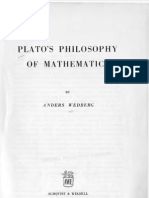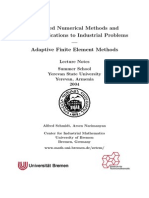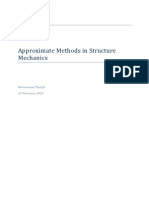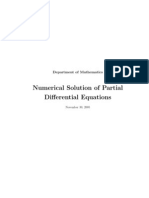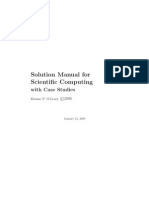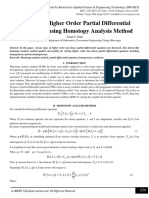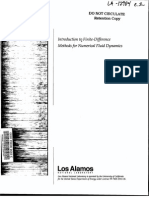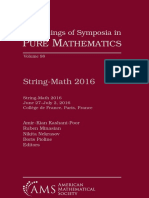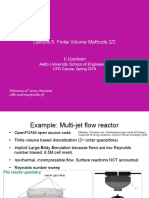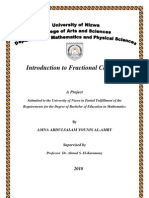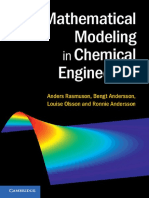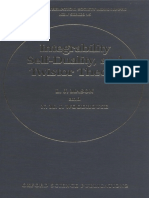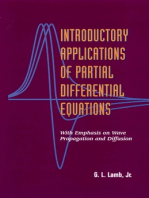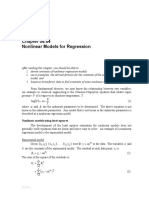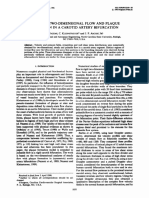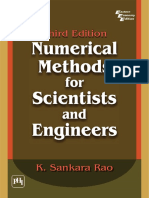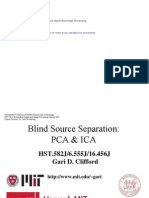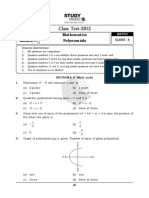Partial Differential Equations of Fluid Dynamics
Partial Differential Equations of Fluid Dynamics
Uploaded by
insanCopyright:
Available Formats
Partial Differential Equations of Fluid Dynamics
Partial Differential Equations of Fluid Dynamics
Uploaded by
insanOriginal Description:
Copyright
Available Formats
Share this document
Did you find this document useful?
Is this content inappropriate?
Copyright:
Available Formats
Partial Differential Equations of Fluid Dynamics
Partial Differential Equations of Fluid Dynamics
Uploaded by
insanCopyright:
Available Formats
Partial Differential Equations of Fluid Dynamics
A Preliminary Step for Pipe Flow Simulations
1
Ville Vuorinen,D.Sc.(Tech.)
1
Department of Energy Technology, Internal Combustion Engine Research Group
Aalto University
Department of Energy Technology
Outline
Introduction
Modeling Transport Phenomena Using PDE’s
Discretization of Derivatives
Numerical Solution of PDE’s
Matlab and PDE’s 2/27
Ville Vuorinen Simulation Course, 2012
Aalto University A Preliminary Step for Pipe Flow Simulations
Role of CFD in Modern Engine Computations 1
Turbulent Intake, Exhaust and Incylinder Flow Using LES (Courtesy of Sandia)
Matlab and PDE’s 3/27
Ville Vuorinen Simulation Course, 2012
Aalto University A Preliminary Step for Pipe Flow Simulations
Role of CFD in Modern Engine Computations 2
Fuel Injection and Turbulence Using LES (Courtesy of Sandia)
Matlab and PDE’s 4/27
Ville Vuorinen Simulation Course, 2012
Aalto University A Preliminary Step for Pipe Flow Simulations
Role of CFD in Modern Engine Computations 3
Cross-Section of Turbulence in Exhaust Manifold Using LES
Matlab and PDE’s 5/27
Ville Vuorinen Simulation Course, 2012
Aalto University A Preliminary Step for Pipe Flow Simulations
Partial Differential Equations
Can Be Used to Model and Simulate 1D, 2D and 3D Flows
Diffusion, convection and radiation are basic trasport mechanisms of
mass, momentum and energy.
Matlab and PDE’s 6/27
Ville Vuorinen Simulation Course, 2012
Aalto University A Preliminary Step for Pipe Flow Simulations
Partial Differential Equations
Can Be Used to Model and Simulate 1D, 2D and 3D Flows
Diffusion, convection and radiation are basic trasport mechanisms of
mass, momentum and energy.
Diffusion, convection and radiation are basic trasport mechanisms
of mass, momentum and energy.
Matlab and PDE’s 6/27
Ville Vuorinen Simulation Course, 2012
Aalto University A Preliminary Step for Pipe Flow Simulations
Partial Differential Equations
Can Be Used to Model and Simulate 1D, 2D and 3D Flows
Diffusion, convection and radiation are basic trasport mechanisms of
mass, momentum and energy.
Diffusion, convection and radiation are basic trasport mechanisms
of mass, momentum and energy.
Example 1: heat conduction (diffusion) via walls of a hot engine
cylinder.
Matlab and PDE’s 6/27
Ville Vuorinen Simulation Course, 2012
Aalto University A Preliminary Step for Pipe Flow Simulations
Partial Differential Equations
Can Be Used to Model and Simulate 1D, 2D and 3D Flows
Diffusion, convection and radiation are basic trasport mechanisms of
mass, momentum and energy.
Diffusion, convection and radiation are basic trasport mechanisms
of mass, momentum and energy.
Example 1: heat conduction (diffusion) via walls of a hot engine
cylinder.
Example 2: transport of concentration of a radioactive cloud in
given wind conditions.
Matlab and PDE’s 6/27
Ville Vuorinen Simulation Course, 2012
Aalto University A Preliminary Step for Pipe Flow Simulations
Partial Differential Equations
Can Be Used to Model and Simulate 1D, 2D and 3D Flows
Diffusion, convection and radiation are basic trasport mechanisms of
mass, momentum and energy.
Diffusion, convection and radiation are basic trasport mechanisms
of mass, momentum and energy.
Example 1: heat conduction (diffusion) via walls of a hot engine
cylinder.
Example 2: transport of concentration of a radioactive cloud in
given wind conditions.
Example 3: convection of hot exhaust gases out of an engine.
Matlab and PDE’s 6/27
Ville Vuorinen Simulation Course, 2012
Aalto University A Preliminary Step for Pipe Flow Simulations
Partial Differential Equations
Can Be Used to Model and Simulate 1D, 2D and 3D Flows
Diffusion, convection and radiation are basic trasport mechanisms of
mass, momentum and energy.
Diffusion, convection and radiation are basic trasport mechanisms
of mass, momentum and energy.
Example 1: heat conduction (diffusion) via walls of a hot engine
cylinder.
Example 2: transport of concentration of a radioactive cloud in
given wind conditions.
Example 3: convection of hot exhaust gases out of an engine.
The phenomena above can all be modeled with partial differential
equations.
Matlab and PDE’s 6/27
Ville Vuorinen Simulation Course, 2012
Aalto University A Preliminary Step for Pipe Flow Simulations
Partial Differential Equations
Can Be Used to Model and Simulate 1D, 2D and 3D Flows
Diffusion, convection and radiation are basic trasport mechanisms of
mass, momentum and energy.
Diffusion, convection and radiation are basic trasport mechanisms
of mass, momentum and energy.
Example 1: heat conduction (diffusion) via walls of a hot engine
cylinder.
Example 2: transport of concentration of a radioactive cloud in
given wind conditions.
Example 3: convection of hot exhaust gases out of an engine.
The phenomena above can all be modeled with partial differential
equations.
This lecture gives an overview of linear PDE’s and the next lecture
on the (non-linear) Navier-Stokes equations.
Matlab and PDE’s 6/27
Ville Vuorinen Simulation Course, 2012
Aalto University A Preliminary Step for Pipe Flow Simulations
Outline
Introduction
Modeling Transport Phenomena Using PDE’s
Discretization of Derivatives
Numerical Solution of PDE’s
Matlab and PDE’s 7/27
Ville Vuorinen Simulation Course, 2012
Aalto University A Preliminary Step for Pipe Flow Simulations
The General Form of Any Transport Phenomenon
Also the Navier-Stokes Equation is of This Form
The Convection-Diffusion Equation for the Quantity φ
temporal derivative
z}|{ convection term diffusion term source term
∂ρφ z }| { z }| { z }| {
+ ∇ · (uρφ) − ∇ · (ρν∇φ) = Sφ (φ)
∂t
φ convects and diffuses in a fluid (e.g. air,water...).
φ could represent e.g. concentration of soot particles in cigarette
smoke or water temperature in ocean currents etc.
ρ is the density of the fluid and u = u(x,y,z,t) the velocity field, and ν
the diffusivity (e.g. heat diffusivity) of φ.
Matlab and PDE’s 8/27
Ville Vuorinen Simulation Course, 2012
Aalto University A Preliminary Step for Pipe Flow Simulations
In 1D the Convection-Diffusion Equation for Tem-
perature T Can Be Written as Follows
1D Form
temporal derivative convection term diffusion term
z}|{ z }| { z }| {
∂T ∂ ∂ ∂
+ (uT) − (ν T) = 0
∂t ∂x ∂x ∂x
Assumption
Fluid is incompressible i.e. ρ= constant (e.g. water or low velocity
<100m/s air).
Matlab and PDE’s 9/27
Ville Vuorinen Simulation Course, 2012
Aalto University A Preliminary Step for Pipe Flow Simulations
When u = 0 One Obtains the Heat Diffusion Equa-
tion
1D Heat Equation
temporal derivative heat diffusion term
z}|{ z }| {
∂T ∂ ∂
= (ν T)
∂t ∂x ∂x
Matlab and PDE’s 10/27
Ville Vuorinen Simulation Course, 2012
Aalto University A Preliminary Step for Pipe Flow Simulations
When ν =Constant the Heat Diffusion Equation
Further Simplifies
1D Heat Equation
temporal derivative heat diffusion term
z}|{ z }| {
∂T ∂ ∂
=ν ( T)
∂t ∂x ∂x
Matlab and PDE’s 11/27
Ville Vuorinen Simulation Course, 2012
Aalto University A Preliminary Step for Pipe Flow Simulations
When ν = 0 One Obtains the Convection Equation
1D Convection Equation
temporal derivative convection term
z}|{ z }| {
∂T ∂
+ (uT) = 0.
∂t ∂x
Assumption
Fluid is incompressible i.e. ρ= constant (e.g. water or low velocity
<100m/s air).
Matlab and PDE’s 12/27
Ville Vuorinen Simulation Course, 2012
Aalto University A Preliminary Step for Pipe Flow Simulations
Again, When u =Constant the Convection Equa-
tion Further Simplifies
1D Convection Equation
temporal derivative convection term
z}|{ z }| {
∂T ∂
+ u (T) = 0.
∂t ∂x
Assumption
Fluid is incompressible i.e. ρ= constant (e.g. water or low velocity
<100m/s air).
Matlab and PDE’s 13/27
Ville Vuorinen Simulation Course, 2012
Aalto University A Preliminary Step for Pipe Flow Simulations
Outline
Introduction
Modeling Transport Phenomena Using PDE’s
Discretization of Derivatives
Numerical Solution of PDE’s
Matlab and PDE’s 14/27
Ville Vuorinen Simulation Course, 2012
Aalto University A Preliminary Step for Pipe Flow Simulations
How to Solve/Simulate the Basic PDE’s Using
Computers?
The continuous equations need to be discretized.
Matlab and PDE’s 15/27
Ville Vuorinen Simulation Course, 2012
Aalto University A Preliminary Step for Pipe Flow Simulations
How to Solve/Simulate the Basic PDE’s Using
Computers?
The continuous equations need to be discretized.
This means that the derivatives have to be expressed using Taylor
series which allows numerical evaluation of the derivative terms.
Matlab and PDE’s 15/27
Ville Vuorinen Simulation Course, 2012
Aalto University A Preliminary Step for Pipe Flow Simulations
How to Solve/Simulate the Basic PDE’s Using
Computers?
The continuous equations need to be discretized.
This means that the derivatives have to be expressed using Taylor
series which allows numerical evaluation of the derivative terms.
Space is divided into finite size elements by replacing dx → ∆x.
Matlab and PDE’s 15/27
Ville Vuorinen Simulation Course, 2012
Aalto University A Preliminary Step for Pipe Flow Simulations
How to Solve/Simulate the Basic PDE’s Using
Computers?
The continuous equations need to be discretized.
This means that the derivatives have to be expressed using Taylor
series which allows numerical evaluation of the derivative terms.
Space is divided into finite size elements by replacing dx → ∆x.
Time is divided into finite size time steps by replacing dt → ∆t.
Matlab and PDE’s 15/27
Ville Vuorinen Simulation Course, 2012
Aalto University A Preliminary Step for Pipe Flow Simulations
How to Solve/Simulate the Basic PDE’s Using
Computers?
The continuous equations need to be discretized.
This means that the derivatives have to be expressed using Taylor
series which allows numerical evaluation of the derivative terms.
Space is divided into finite size elements by replacing dx → ∆x.
Time is divided into finite size time steps by replacing dt → ∆t.
The basic idea: timesteps are numbered from
0, 1, 2, ..., n − 1, n, n + 1, ..., N corresponding to physical times
total simulation period(s)
0, ∆t, 2∆t, ..., N∆t, where N = .
∆t
Matlab and PDE’s 15/27
Ville Vuorinen Simulation Course, 2012
Aalto University A Preliminary Step for Pipe Flow Simulations
How to Solve/Simulate the Basic PDE’s Using
Computers?
The continuous equations need to be discretized.
This means that the derivatives have to be expressed using Taylor
series which allows numerical evaluation of the derivative terms.
Space is divided into finite size elements by replacing dx → ∆x.
Time is divided into finite size time steps by replacing dt → ∆t.
The basic idea: timesteps are numbered from
0, 1, 2, ..., n − 1, n, n + 1, ..., N corresponding to physical times
total simulation period(s)
0, ∆t, 2∆t, ..., N∆t, where N = .
∆t
At nth timestep we want to know the solution at the (n + 1)th
timestep using solution Tn .
Matlab and PDE’s 15/27
Ville Vuorinen Simulation Course, 2012
Aalto University A Preliminary Step for Pipe Flow Simulations
How to Solve/Simulate the Basic PDE’s Using
Computers? (cont.)
Here Tn = Tn (k · ∆x) = Tnk , where k = 0, 1, 2, ..., L/∆x i.e. the
solution at timestep is defined in discrete space points
0, ∆x, 2∆x, ....
Matlab and PDE’s 16/27
Ville Vuorinen Simulation Course, 2012
Aalto University A Preliminary Step for Pipe Flow Simulations
How to Solve/Simulate the Basic PDE’s Using
Computers? (cont.)
Here Tn = Tn (k · ∆x) = Tnk , where k = 0, 1, 2, ..., L/∆x i.e. the
solution at timestep is defined in discrete space points
0, ∆x, 2∆x, ....
Simulation of e.g. heat or convection equation means that for every
single discrete point (or ’cell’) we want to find a general update
formula in order to advance the solution from timestep n to time
n + 1.
Matlab and PDE’s 16/27
Ville Vuorinen Simulation Course, 2012
Aalto University A Preliminary Step for Pipe Flow Simulations
Discretization of Time
A Simple First Order Taylor Series Approximation Gives
temporal derivative numerical approximation
z}|{ z }| {
∂T Tn+1 − Tn
≈ +O(∆t).
∂t ∆t
Above, = O(∆t) is the time discretization error.
Matlab and PDE’s 17/27
Ville Vuorinen Simulation Course, 2012
Aalto University A Preliminary Step for Pipe Flow Simulations
Discretization of Time
A Simple First Order Taylor Series Approximation Gives
temporal derivative numerical approximation
z}|{ z }| {
∂T Tn+1 − Tn
≈ +O(∆t).
∂t ∆t
Above, = O(∆t) is the time discretization error.
O(∆t) → 0 when ∆t → 0.
Matlab and PDE’s 17/27
Ville Vuorinen Simulation Course, 2012
Aalto University A Preliminary Step for Pipe Flow Simulations
Discretization of First Derivative in Space
A Simple Second Order Central Difference Taylor Series
Approximation Gives
spatial derivative numerical approximation
z}|{ z }| {
∂T T k+1 − T k−1
≈ +O(∆x2 ).
∂x 2∆x
Above, = O(∆x2 ) is the space discretization error.
Matlab and PDE’s 18/27
Ville Vuorinen Simulation Course, 2012
Aalto University A Preliminary Step for Pipe Flow Simulations
Discretization of First Derivative in Space
A Simple Second Order Central Difference Taylor Series
Approximation Gives
spatial derivative numerical approximation
z}|{ z }| {
∂T T k+1 − T k−1
≈ +O(∆x2 ).
∂x 2∆x
Above, = O(∆x2 ) is the space discretization error.
O(∆x2 ) → 0 when ∆x → 0.
Matlab and PDE’s 18/27
Ville Vuorinen Simulation Course, 2012
Aalto University A Preliminary Step for Pipe Flow Simulations
Discretization of Second Derivative in Space
Central Difference Formula for T 00 (x)
second spatial derivative numerical approximation
z}|{ z }| {
∂2T T k+1 − 2T k + T k−1
≈ +O(∆x2 ).
∂x2 ∆x2
Above, = O(∆x2 ) is the space discretization error.
Matlab and PDE’s 19/27
Ville Vuorinen Simulation Course, 2012
Aalto University A Preliminary Step for Pipe Flow Simulations
Discretization of Second Derivative in Space
Central Difference Formula for T 00 (x)
second spatial derivative numerical approximation
z}|{ z }| {
∂2T T k+1 − 2T k + T k−1
≈ +O(∆x2 ).
∂x2 ∆x2
Above, = O(∆x2 ) is the space discretization error.
O(∆x2 ) → 0 when ∆x → 0.
Matlab and PDE’s 19/27
Ville Vuorinen Simulation Course, 2012
Aalto University A Preliminary Step for Pipe Flow Simulations
Outline
Introduction
Modeling Transport Phenomena Using PDE’s
Discretization of Derivatives
Numerical Solution of PDE’s
Matlab and PDE’s 20/27
Ville Vuorinen Simulation Course, 2012
Aalto University A Preliminary Step for Pipe Flow Simulations
Explicit Euler Method for the Convection Equation
Update Formula
k
Tn+1 − Tnk T k+1 − Tnk−1
+u n = 0.
∆t 2∆x
Or Moving the Known Terms to Right Hand Side
Courant Number
z }| {
k Tnk+1− Tnk−1 u∆t Tnk+1 − Tnk−1
Tn+1 = Tnk − u∆t = Tnk −
2∆x ∆x 2
Matlab and PDE’s 21/27
Ville Vuorinen Simulation Course, 2012
Aalto University A Preliminary Step for Pipe Flow Simulations
Explicit Euler Method for the Heat (Diffusion)
Equation
Update Formula
k
Tn+1 − Tnk T k+1 − 2Tnk + Tnk−1
=ν n = 0.
∆t ∆x2
Or Moving the Known Terms to Right Hand Side
Courant-Friedrichs-Lewy Number
z }| {
k ν∆t
Tn+1 = Tnk + (Tnk+1 − 2Tnk + Tnk−1 )
∆x2
Matlab and PDE’s 22/27
Ville Vuorinen Simulation Course, 2012
Aalto University A Preliminary Step for Pipe Flow Simulations
Stability Limits
Courant Number
u∆t
The Courant number Co = describes the propagation distance
∆x
of information during timestep ∆t.
Matlab and PDE’s 23/27
Ville Vuorinen Simulation Course, 2012
Aalto University A Preliminary Step for Pipe Flow Simulations
Stability Limits
Courant Number
u∆t
The Courant number Co = describes the propagation distance
∆x
of information during timestep ∆t.
It is necessary that Co < 1 for physically meaningfull solution.
Matlab and PDE’s 23/27
Ville Vuorinen Simulation Course, 2012
Aalto University A Preliminary Step for Pipe Flow Simulations
Stability Limits
Courant Number
u∆t
The Courant number Co = describes the propagation distance
∆x
of information during timestep ∆t.
It is necessary that Co < 1 for physically meaningfull solution.
For explicit Euler method Co < 1/2 sets the limit for timestep for the
algorithm to be numerically stable.
Matlab and PDE’s 23/27
Ville Vuorinen Simulation Course, 2012
Aalto University A Preliminary Step for Pipe Flow Simulations
Stability Limits (cont.)
Courant-Friedrichs-Lewy Number
ν∆t
The Courant-Friedrichs-Lewy Number CFL = describes the
∆x2
diffusion distance of information during timestep ∆t.
Matlab and PDE’s 24/27
Ville Vuorinen Simulation Course, 2012
Aalto University A Preliminary Step for Pipe Flow Simulations
Stability Limits (cont.)
Courant-Friedrichs-Lewy Number
ν∆t
The Courant-Friedrichs-Lewy Number CFL = describes the
∆x2
diffusion distance of information during timestep ∆t.
Again, it is necessary that CFL < 1 for physically meaningfull
solution.
Matlab and PDE’s 24/27
Ville Vuorinen Simulation Course, 2012
Aalto University A Preliminary Step for Pipe Flow Simulations
Stability Limits (cont.)
Courant-Friedrichs-Lewy Number
ν∆t
The Courant-Friedrichs-Lewy Number CFL = describes the
∆x2
diffusion distance of information during timestep ∆t.
Again, it is necessary that CFL < 1 for physically meaningfull
solution.
Again, for explicit Euler method CFL < 1/2 sets the limit for
timestep for the algorithm to be numerically stable.
Matlab and PDE’s 24/27
Ville Vuorinen Simulation Course, 2012
Aalto University A Preliminary Step for Pipe Flow Simulations
Matlab Implementation
The folder /demos2012/ shows demo files in which the Explicit
Euler method is applied for heat diffusion and convection-diffusion
equations.
ConvectionDiffusionEquation.m and HeatDiffusion.m
demonstrate these examples.
The files PlottingFigure.m, SurfaceAnimation.m and
DrawingSurface.m show how graphs can be drawn, surface motion
be animated etc.
Matlab and PDE’s 25/27
Ville Vuorinen Simulation Course, 2012
Aalto University A Preliminary Step for Pipe Flow Simulations
Summary
An introduction to PDE’s and numerical solution using the explicit
Euler method was given.
Matlab and PDE’s 26/27
Ville Vuorinen Simulation Course, 2012
Aalto University A Preliminary Step for Pipe Flow Simulations
Summary
An introduction to PDE’s and numerical solution using the explicit
Euler method was given.
It is very easy to extend the present knowledge to e.g. the
Runge-Kutta-methods which would provide more robustness and
stability.
Matlab and PDE’s 26/27
Ville Vuorinen Simulation Course, 2012
Aalto University A Preliminary Step for Pipe Flow Simulations
Summary
An introduction to PDE’s and numerical solution using the explicit
Euler method was given.
It is very easy to extend the present knowledge to e.g. the
Runge-Kutta-methods which would provide more robustness and
stability.
In the next lecture we will show that you can already directly apply
the learned methods and PDE’s to non-linear the non-linear realistic
case of the Navier-Stokes equation for a 1D pipe flow.
Matlab and PDE’s 26/27
Ville Vuorinen Simulation Course, 2012
Aalto University A Preliminary Step for Pipe Flow Simulations
The End
Thank you
Questions?
Matlab and PDE’s 27/27
Ville Vuorinen Simulation Course, 2012
Aalto University A Preliminary Step for Pipe Flow Simulations
You might also like
- Notes On CFD General Principles - 3.22 Bounded Advection Discretisation (Unknown) (Z-Library)Document195 pagesNotes On CFD General Principles - 3.22 Bounded Advection Discretisation (Unknown) (Z-Library)huy.nguyenhaitanNo ratings yet
- Plato's Philosophy of Mathematics - Anders WedbergDocument152 pagesPlato's Philosophy of Mathematics - Anders Wedbergblavska100% (5)
- Boundary Element and Finite Element MethodsDocument73 pagesBoundary Element and Finite Element MethodsticoncoolzNo ratings yet
- Acm/Icpc Cheatsheet: PuzzlesDocument26 pagesAcm/Icpc Cheatsheet: PuzzlesDevendraReddyPoreddyNo ratings yet
- Elements of Computational Fluid Dynamics: P. WesselingDocument147 pagesElements of Computational Fluid Dynamics: P. WesselingLuis Felipe Gutierrez MarcantoniNo ratings yet
- Module - 1 - Updated 15 July 2020Document81 pagesModule - 1 - Updated 15 July 2020ermiasNo ratings yet
- MA8491 Notes NM - by EasyEngineering - Net 5Document100 pagesMA8491 Notes NM - by EasyEngineering - Net 55060 Karthikeyan. MNo ratings yet
- NumerPDEs LectureDocument406 pagesNumerPDEs Lecture李軒No ratings yet
- MATLAB PROGRAMMING An Engineering PerspectiveDocument129 pagesMATLAB PROGRAMMING An Engineering PerspectivelolaNo ratings yet
- Comp Heat Transfer4 Repaired)Document48 pagesComp Heat Transfer4 Repaired)Rozanti A. HamidNo ratings yet
- Numericalsolutionof Differentialequations: 13:40:38, Subject To The Cambridge CoreDocument303 pagesNumericalsolutionof Differentialequations: 13:40:38, Subject To The Cambridge Corehaithamelramlawi7503No ratings yet
- VOLTERRA INTEGRAL EQUATIONS .RuDocument15 pagesVOLTERRA INTEGRAL EQUATIONS .RujokdannyNo ratings yet
- Advanced Numerical MethodsDocument160 pagesAdvanced Numerical MethodsvanbuytenNo ratings yet
- Approximate Methods - Weighted Residual MethodsDocument30 pagesApproximate Methods - Weighted Residual MethodsMohammad Tawfik100% (2)
- NSPDEDocument118 pagesNSPDEKamal NikhurpaNo ratings yet
- Steady-State and Unsteady-State Flow of Non':'Newtonian Fluids Through Porous MediaDocument9 pagesSteady-State and Unsteady-State Flow of Non':'Newtonian Fluids Through Porous Mediazulike2004No ratings yet
- Partial Differential Equations: Analytical and Numerical MethodsDocument136 pagesPartial Differential Equations: Analytical and Numerical MethodsMohamed Mounir FekriNo ratings yet
- Solutions Manual Scientific ComputingDocument192 pagesSolutions Manual Scientific ComputingSanjeev Gupta0% (1)
- Center Manifold ReductionDocument8 pagesCenter Manifold Reductionsunoval2013100% (2)
- Solution of Higher Order Partial Differential Equation by Using Homotopy Analysis MethodDocument5 pagesSolution of Higher Order Partial Differential Equation by Using Homotopy Analysis MethodIJRASETPublicationsNo ratings yet
- Simple Brownian DiffusionDocument5 pagesSimple Brownian DiffusionIgnasi AlemanyNo ratings yet
- Ch. 4 Roundoff and Truncation ErrorsDocument16 pagesCh. 4 Roundoff and Truncation ErrorsFh HNo ratings yet
- Commutative Algebra and Its ApplicationsDocument394 pagesCommutative Algebra and Its ApplicationsMadhu JampalaNo ratings yet
- Modeling With Penalized SplinesDocument50 pagesModeling With Penalized SplinesrahmiNo ratings yet
- Models - Ssf.forchheimer FlowDocument12 pagesModels - Ssf.forchheimer FlowGerryNo ratings yet
- Elementary Course On PDEs by TMKDocument199 pagesElementary Course On PDEs by TMKgrvmaurya999No ratings yet
- Fem 2Document26 pagesFem 2Venkitaraj K PNo ratings yet
- Burger's EquationDocument10 pagesBurger's EquationPaneendraBhatNo ratings yet
- Introduction To Finite Difference Methods For Numerical Fluid DynamicsDocument214 pagesIntroduction To Finite Difference Methods For Numerical Fluid Dynamicsprashanthreddy26No ratings yet
- (Carlo Cercignani, Ester Gabetta) Transport Phenom (BookFi)Document274 pages(Carlo Cercignani, Ester Gabetta) Transport Phenom (BookFi)Shilbhushan Shambharkar100% (2)
- Thermodynamics of Fracture GrowthDocument13 pagesThermodynamics of Fracture GrowthMugume Rodgers Bangi100% (2)
- R.B.V.R.R Women'S College (Autonomous) Department of Mathematics M.Sc. Semester III Paper-III Syllabus 2017-18Document2 pagesR.B.V.R.R Women'S College (Autonomous) Department of Mathematics M.Sc. Semester III Paper-III Syllabus 2017-18Abhay Pratap SharmaNo ratings yet
- The University of Edinburgh Dynamical Systems Problem SetDocument4 pagesThe University of Edinburgh Dynamical Systems Problem SetHaaziquah TahirNo ratings yet
- Finite Element Method MV - 6251: by Cap. Dr. Riessom W/GiorgisDocument32 pagesFinite Element Method MV - 6251: by Cap. Dr. Riessom W/Giorgisbiruk1No ratings yet
- Fluid Dynamics - NoteDocument60 pagesFluid Dynamics - NoteshambelNo ratings yet
- 10 - 1 - Numerical PDE PDFDocument49 pages10 - 1 - Numerical PDE PDFLuqman HardiyanNo ratings yet
- Optimal Control: Wave EquationDocument32 pagesOptimal Control: Wave EquationRamdas SonawaneNo ratings yet
- AMU Applied - III - 2 Lecture Note PDFDocument103 pagesAMU Applied - III - 2 Lecture Note PDFISRAEL HAILUNo ratings yet
- CONM TechMax SyllabusDocument12 pagesCONM TechMax Syllabusshyjuother97730% (2)
- (Proceedings of Symposia in Pure Mathematics 98) Amir-Kian Kashani-Poor, Ruben Minasian, Nikita Nekrasov, Boris Pioline, Editors-String-Math 2016-American Mathematical Society (2018) PDFDocument314 pages(Proceedings of Symposia in Pure Mathematics 98) Amir-Kian Kashani-Poor, Ruben Minasian, Nikita Nekrasov, Boris Pioline, Editors-String-Math 2016-American Mathematical Society (2018) PDFLav100% (1)
- C I V 5 0 3 Finite Element Analysis: DR Zubair Syed, MieaustDocument57 pagesC I V 5 0 3 Finite Element Analysis: DR Zubair Syed, MieaustHaytham AlmaghariNo ratings yet
- Advanced Mathematics &mechanics Applications Using MATLABDocument10 pagesAdvanced Mathematics &mechanics Applications Using MATLABHéctor PaprikaNo ratings yet
- Lecture05 FVM2Document48 pagesLecture05 FVM2alejandrovelez100% (1)
- Lid Driven Cavity Using Simple AlgorithmDocument14 pagesLid Driven Cavity Using Simple Algorithmsahilnagula0504No ratings yet
- Introduction To Fractional Calculus Amna Al - Amri Project October 2010Document29 pagesIntroduction To Fractional Calculus Amna Al - Amri Project October 2010karamaniNo ratings yet
- 769513Document196 pages769513Aman SrivastavaNo ratings yet
- Microsoft Word - 21af04 - PDEDocument35 pagesMicrosoft Word - 21af04 - PDEJuvil GotelNo ratings yet
- Praktikum 4 18122014Document31 pagesPraktikum 4 18122014George Michael Alvarado LopezNo ratings yet
- Kinetic Models of Sorption Theoretical AnalysisDocument6 pagesKinetic Models of Sorption Theoretical AnalysisDiogo DiasNo ratings yet
- Applied Mathematics in Engineering and Reliability PDFDocument354 pagesApplied Mathematics in Engineering and Reliability PDFJayson Jonson AraojoNo ratings yet
- An Analysis of The Viscous BehaviourDocument6 pagesAn Analysis of The Viscous BehaviourCarlos GuerreroNo ratings yet
- Best Mathematical Methods NotesDocument299 pagesBest Mathematical Methods NotesThomas JanèsNo ratings yet
- Incompressible Fluid Mechanics PDFDocument187 pagesIncompressible Fluid Mechanics PDFPrabhat PiyushNo ratings yet
- (Lionel J. Mason, Nicholas Michael John Woodhouse) (Bokos-Z1)Document374 pages(Lionel J. Mason, Nicholas Michael John Woodhouse) (Bokos-Z1)rebe53No ratings yet
- Tagore's Red Oleanders-Quest For Emancipation of HumanityDocument62 pagesTagore's Red Oleanders-Quest For Emancipation of HumanityRonnie0209No ratings yet
- How Dilute Are Dilute Solutions in Extensional Flows?: C. Clasen, J. P. Plog, and W.-M. KulickeDocument33 pagesHow Dilute Are Dilute Solutions in Extensional Flows?: C. Clasen, J. P. Plog, and W.-M. Kulickemexicanu99No ratings yet
- Introduction To Mat Lab: First Year Chemical Engineering DepartmentDocument43 pagesIntroduction To Mat Lab: First Year Chemical Engineering DepartmentDouda SamihNo ratings yet
- Matrices, Moments and Quadrature with ApplicationsFrom EverandMatrices, Moments and Quadrature with ApplicationsRating: 5 out of 5 stars5/5 (1)
- Introductory Applications of Partial Differential Equations: With Emphasis on Wave Propagation and DiffusionFrom EverandIntroductory Applications of Partial Differential Equations: With Emphasis on Wave Propagation and DiffusionNo ratings yet
- Extended Rules For Commas - Purdue Writing LabDocument10 pagesExtended Rules For Commas - Purdue Writing LabinsanNo ratings yet
- Numerical Studies of Fluid Flow Through TubesDocument14 pagesNumerical Studies of Fluid Flow Through TubesinsanNo ratings yet
- Nanda Kumar 2015Document7 pagesNanda Kumar 2015insanNo ratings yet
- BEST PDF On LinearAlgebraDocument39 pagesBEST PDF On LinearAlgebrainsan100% (2)
- AnuDocument14 pagesAnuinsanNo ratings yet
- Nonlinear Models For Regression: P T T B A P A BDocument22 pagesNonlinear Models For Regression: P T T B A P A BinsanNo ratings yet
- Naze Mi 1990Document7 pagesNaze Mi 1990insanNo ratings yet
- SIAUT Fuel Injection Systems-DieselDocument39 pagesSIAUT Fuel Injection Systems-DieselAbhishek KohliNo ratings yet
- 1 PDFDocument14 pages1 PDFinsanNo ratings yet
- Sample 7394Document11 pagesSample 7394insan100% (1)
- Module 6 (Maths)Document100 pagesModule 6 (Maths)Adabala Durgarao NaiduNo ratings yet
- Random Variable 1 PDFDocument4 pagesRandom Variable 1 PDFwhatthefuNo ratings yet
- Karnaugh Map - Don't Care Conditions - Tabulation Method: Simplification TechniquesDocument31 pagesKarnaugh Map - Don't Care Conditions - Tabulation Method: Simplification TechniquesMithun GoudaNo ratings yet
- Mahler Practice Exam 1Document19 pagesMahler Practice Exam 1Chong Yin WaiNo ratings yet
- D. Cal Assignment1127Document3 pagesD. Cal Assignment1127Moshfik Hasan MahimNo ratings yet
- Data Projections & Visualization: Student Eng.: Maria-Alexandra MATEIDocument18 pagesData Projections & Visualization: Student Eng.: Maria-Alexandra MATEISakura AlexaNo ratings yet
- 1st Grade Math Homework HelpDocument5 pages1st Grade Math Homework Helph3ya7wp9100% (1)
- Math 7 Unit 2 OverviewDocument2 pagesMath 7 Unit 2 Overviewapi-314307886No ratings yet
- Course - Outline - Math 2030B - F2019 PDFDocument5 pagesCourse - Outline - Math 2030B - F2019 PDFjair2018No ratings yet
- Blind Source SeparationDocument64 pagesBlind Source Separationchristina90No ratings yet
- Class Test Polynomials-XDocument2 pagesClass Test Polynomials-XGovind AhujaNo ratings yet
- Concepts of Squares and Pythagorean TripletDocument5 pagesConcepts of Squares and Pythagorean TripletHardik RathoreNo ratings yet
- Kufa 2Document1,041 pagesKufa 2Karwan JwamerNo ratings yet
- Curriculum Map Math 7Document13 pagesCurriculum Map Math 7Ralph Francis Bautista100% (1)
- Spatial Econometrics IntroductionDocument42 pagesSpatial Econometrics IntroductionMoniefMydomainNo ratings yet
- Notes 16Document2 pagesNotes 16GsheudhehNo ratings yet
- Charotar University of Science and TechnologyDocument39 pagesCharotar University of Science and TechnologyNityam JoshiNo ratings yet
- NumbersDocument9 pagesNumbersbrkNo ratings yet
- Grade 10 Output EditedDocument29 pagesGrade 10 Output EditedGen-GenAlcantaraBaldadoNo ratings yet
- Lecture 9Document10 pagesLecture 9emwiti658No ratings yet
- VA TECH Transformer DesignDocument7 pagesVA TECH Transformer DesignVardaShahidNo ratings yet
- Unit-2 Part 15 Solved Question Deviations Taken From Arithmetic Means of X and YDocument2 pagesUnit-2 Part 15 Solved Question Deviations Taken From Arithmetic Means of X and YSumit BainNo ratings yet
- Math Lesson PlanDocument11 pagesMath Lesson Planjessa salitaNo ratings yet
- Variational Methods IntroDocument68 pagesVariational Methods Introliuhuaxia.japanNo ratings yet
- Manav Rachna International Institute of Reasearch & Studies: Faculty of Engineering and TechnologyDocument3 pagesManav Rachna International Institute of Reasearch & Studies: Faculty of Engineering and TechnologyGamerSPIDEYNo ratings yet
- Model Paper-4Document122 pagesModel Paper-4S Kalu SivalingamNo ratings yet
- Collective Sheet 10-Fractions BookletDocument8 pagesCollective Sheet 10-Fractions BookletbtzkvfznmbtqskjqwbNo ratings yet

